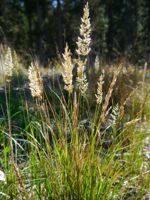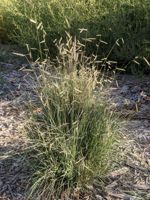Mon-Fri 9am - 5pm Mountain time
Pinegrass vs Blue Grama Grass
Calamagrostis rubescens
Bouteloua gracilis
CUSTOM GROW
NOT AVAILABLE THIS SEASON - MIGHT RETURN
Pinegrass is a hardy, native perennial grass common in forested regions of western North America. It is an important understory species and is typically found beneath conifer canopies. Due to its spreading nature and ability to form dense mats that cover the forest floor, it helps stabilize soils and reduce erosion.
It provides forage for wildlife and livestock, shelter for small animals, and seeds for birds, playing an important ecological role in woodland ecosystems. Pinegrass is well-suited for ecological restoration, soil stabilization, and naturalization projects.
Blue Grama is a native perennial bunchgrass recognized for its blue-green blades and unique seed heads. They grow along one side of the stem and are often compared to eyelashes, eyebrows, or mosquito larvae, which inspired its common names, Eyelash Grass and Mosquito Grass. As the seed heads begin to dry in the fall, they curl, further enhancing the plant’s distinctive appearance. The seeds provide food for birds, and the grass serves as a host plant for certain species of skipper butterflies.
As a warm-season grass, Blue Grama has a slow start in spring and does not actively grow until soil temperatures rise. Its deep roots help with erosion control, and the grass is drought-tolerant once established, thriving even in poor or alkaline soils. It is well-suited for soil stabilization, naturalization, restoration projects, or as an ornamental accent in gardens and landscapes.

